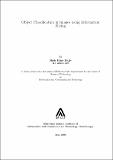Please use this identifier to cite or link to this item:
http://drsr.daiict.ac.in//handle/123456789/205Full metadata record
| DC Field | Value | Language |
|---|---|---|
| dc.contributor.advisor | Mitra, Suman K. | |
| dc.contributor.advisor | Banerjee, Asim | |
| dc.contributor.author | Shah, Hina Rajiv | |
| dc.date.accessioned | 2017-06-10T14:37:30Z | |
| dc.date.available | 2017-06-10T14:37:30Z | |
| dc.date.issued | 2008 | |
| dc.identifier.citation | Shah, Hina Rajiv (2008). Object classification in images using information slicing. Dhirubhai Ambani Institute of Information and Communication Technology, viii, 45 p. (Acc.No: T00168) | |
| dc.identifier.uri | http://drsr.daiict.ac.in/handle/123456789/205 | |
| dc.description.abstract | Human visual system, in real world, identifies objects by their shapes, sizes and colors. More than often we identify objects around us specifically by using contextual knowledge of the objects. For example, an area of vegetation when seen in satellite imagery, if surrounded by a barren land might be identified as a region of woods, while the one surrounded by urban area would be considered as a park. Conventional methods of classification for images, use the spectral information given in by pixels and their neighbors as information for classification, be it supervised or the unsupervised method. However, the information thus used seems to be incomplete in a sense that only local information of the pixels is used for the purpose. Moreover, this does not imitate human visual system of identifying the objects. An attempt has been made here to perform supervised Classification of Objects in Images using Information Slicing. These objects are obtained by using proper segmentation methods. Feature vectors from these segments representing the objects are calculated. Feature vectors are then given as an input to a classifier for classification. Information slicing for classification involves identifying regions in the feature space for the definite classes. Basically this method consists of partitioning the feature space every time into several regions and identify these regions as to which class the region belongs to. If for a region, it cannot be identified what class it belongs to, the feature space is partitioned again with higher number of regions defined in the feature space. This training leads to a very simple classification procedure. Classification then consists of find-and-assign problem. This feature space partitioning method for classification is a supervised one, and effectively works on highly overlapped data. Real time systems when described by feature vectors for the purpose of classification, more than often tend to have overlapping regions between the classes. The classifier hence performs misclassifications. This is also true for classes of objects in images. This dissertation deals with study of Object Classification in Images using Information Slicing method for classification. This includes identification of objects in an image, extracting meaningful features and finally classifying the objects on the basis of proper subset of features extracted using feature space partitioning. | |
| dc.publisher | Dhirubhai Ambani Institute of Information and Communication Technology | |
| dc.subject | Image processing | |
| dc.subject | Digital techniques | |
| dc.subject | Visual texture recognition | |
| dc.subject | Data processing | |
| dc.subject | Algorithms | |
| dc.subject | Optical pattern recognition | |
| dc.classification.ddc | 621.367802856 SHA | |
| dc.title | Object classification in images using information slicing | |
| dc.type | Dissertation | |
| dc.degree | M. Tech | |
| dc.student.id | 200611032 | |
| dc.accession.number | T00168 | |
| Appears in Collections: | M Tech Dissertations | |
Files in This Item:
| File | Description | Size | Format | |
|---|---|---|---|---|
| 200611032.pdf Restricted Access | 2.27 MB | Adobe PDF |  View/Open Request a copy |
Items in DSpace are protected by copyright, with all rights reserved, unless otherwise indicated.
